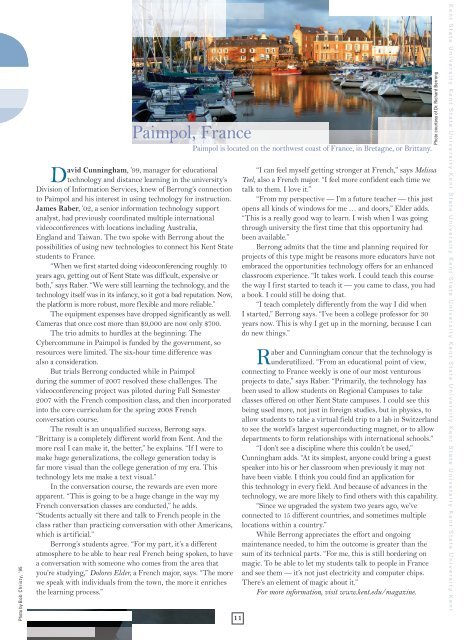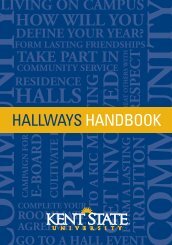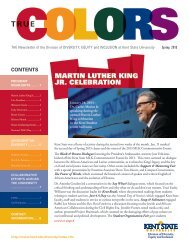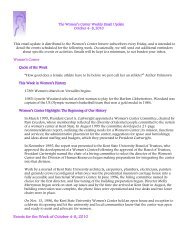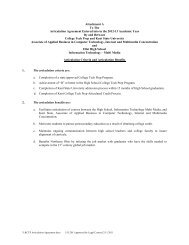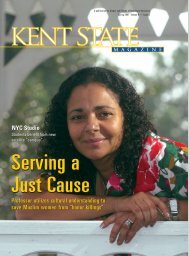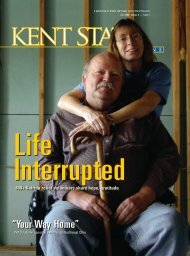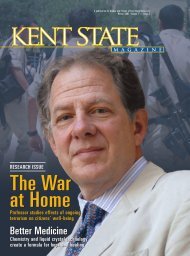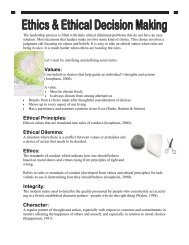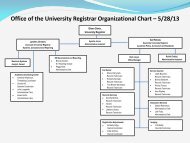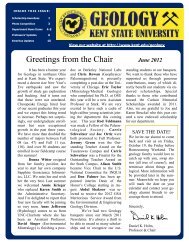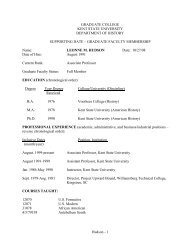E is for Education/Elephant - Kent State University
E is for Education/Elephant - Kent State University
E is for Education/Elephant - Kent State University
Create successful ePaper yourself
Turn your PDF publications into a flip-book with our unique Google optimized e-Paper software.
Photo by Bob Chr<strong>is</strong>ty, ’95<br />
Paimpol, France<br />
David Cunningham, ’99, manager <strong>for</strong> educational<br />
technology and d<strong>is</strong>tance learning in the university’s<br />
Div<strong>is</strong>ion of In<strong>for</strong>mation Services, knew of Berrong’s connection<br />
to Paimpol and h<strong>is</strong> interest in using technology <strong>for</strong> instruction.<br />
James Raber, ’02, a senior in<strong>for</strong>mation technology support<br />
analyst, had previously coordinated multiple international<br />
videoconferences with locations including Australia,<br />
England and Taiwan. The two spoke with Berrong about the<br />
possibilities of using new technologies to connect h<strong>is</strong> <strong>Kent</strong> <strong>State</strong><br />
students to France.<br />
“When we first started doing videoconferencing roughly 10<br />
years ago, getting out of <strong>Kent</strong> <strong>State</strong> was difficult, expensive or<br />
both,” says Raber. “We were still learning the technology, and the<br />
technology itself was in its infancy, so it got a bad reputation. Now,<br />
the plat<strong>for</strong>m <strong>is</strong> more robust, more flexible and more reliable.”<br />
The equipment expenses have dropped significantly as well.<br />
Cameras that once cost more than $9,000 are now only $700.<br />
The trio admits to hurdles at the beginning. The<br />
Cybercommune in Paimpol <strong>is</strong> funded by the government, so<br />
resources were limited. The six-hour time difference was<br />
also a consideration.<br />
But trials Berrong conducted while in Paimpol<br />
during the summer of 2007 resolved these challenges. The<br />
videoconferencing project was piloted during Fall Semester<br />
2007 with the French composition class, and then incorporated<br />
into the core curriculum <strong>for</strong> the spring 2008 French<br />
conversation course.<br />
The result <strong>is</strong> an unqualified success, Berrong says.<br />
“Brittany <strong>is</strong> a completely different world from <strong>Kent</strong>. And the<br />
more real I can make it, the better,” he explains. “If I were to<br />
make huge generalizations, the college generation today <strong>is</strong><br />
far more v<strong>is</strong>ual than the college generation of my era. Th<strong>is</strong><br />
technology lets me make a text v<strong>is</strong>ual.”<br />
In the conversation course, the rewards are even more<br />
apparent. “Th<strong>is</strong> <strong>is</strong> going to be a huge change in the way my<br />
French conversation classes are conducted,” he adds.<br />
“Students actually sit there and talk to French people in the<br />
class rather than practicing conversation with other Americans,<br />
which <strong>is</strong> artificial.”<br />
Berrong’s students agree. “For my part, it’s a different<br />
atmosphere to be able to hear real French being spoken, to have<br />
a conversation with someone who comes from the area that<br />
you’re studying,” Dolores Elder, a French major, says. “The more<br />
we speak with individuals from the town, the more it enriches<br />
the learning process.”<br />
Paimpol <strong>is</strong> located on the northwest coast of France, in Bretagne, or Brittany.<br />
11<br />
“I can feel myself getting stronger at French,” says Mel<strong>is</strong>sa<br />
Teel, also a French major. “I feel more confident each time we<br />
talk to them. I love it.”<br />
“From my perspective — I’m a future teacher — th<strong>is</strong> just<br />
opens all kinds of windows <strong>for</strong> me … and doors,” Elder adds.<br />
“Th<strong>is</strong> <strong>is</strong> a really good way to learn. I w<strong>is</strong>h when I was going<br />
through university the first time that th<strong>is</strong> opportunity had<br />
been available.”<br />
Berrong admits that the time and planning required <strong>for</strong><br />
projects of th<strong>is</strong> type might be reasons more educators have not<br />
embraced the opportunities technology offers <strong>for</strong> an enhanced<br />
classroom experience. “It takes work. I could teach th<strong>is</strong> course<br />
the way I first started to teach it — you came to class, you had<br />
a book. I could still be doing that.<br />
“I teach completely differently from the way I did when<br />
I started,” Berrong says. “I’ve been a college professor <strong>for</strong> 30<br />
years now. Th<strong>is</strong> <strong>is</strong> why I get up in the morning, because I can<br />
do new things.”<br />
Raber and Cunningham concur that the technology <strong>is</strong><br />
underutilized. “From an educational point of view,<br />
connecting to France weekly <strong>is</strong> one of our most venturous<br />
projects to date,” says Raber. “Primarily, the technology has<br />
been used to allow students on Regional Campuses to take<br />
classes offered on other <strong>Kent</strong> <strong>State</strong> campuses. I could see th<strong>is</strong><br />
being used more, not just in <strong>for</strong>eign studies, but in physics, to<br />
allow students to take a virtual field trip to a lab in Switzerland<br />
to see the world’s largest superconducting magnet, or to allow<br />
departments to <strong>for</strong>m relationships with international schools.”<br />
“I don’t see a d<strong>is</strong>cipline where th<strong>is</strong> couldn’t be used,”<br />
Cunningham adds. “At its simplest, anyone could bring a guest<br />
speaker into h<strong>is</strong> or her classroom when previously it may not<br />
have been viable. I think you could find an application <strong>for</strong><br />
th<strong>is</strong> technology in every field. And because of advances in the<br />
technology, we are more likely to find others with th<strong>is</strong> capability.<br />
“Since we upgraded the system two years ago, we’ve<br />
connected to 15 different countries, and sometimes multiple<br />
locations within a country.”<br />
While Berrong appreciates the ef<strong>for</strong>t and ongoing<br />
maintenance needed, to him the outcome <strong>is</strong> greater than the<br />
sum of its technical parts. “For me, th<strong>is</strong> <strong>is</strong> still bordering on<br />
magic. To be able to let my students talk to people in France<br />
and see them — it’s not just electricity and computer chips.<br />
There’s an element of magic about it.”<br />
For more in<strong>for</strong>mation, v<strong>is</strong>it www.kent.edu/magazine.<br />
Photo courtesy of Dr. Richard Berrong<br />
K e n t S t a t e U n i v e r s i t y K e n t S t a t e U n i v e r s i t y K e n t S t a t e U n i v e r s i t y K e n t S t a t e U n i v e r s i t y K e n t S t a t e U n i v e r s i t y K e n t S t a t e U n i v e r s i t y K e n t S t a t e U n i v e r s i t y K e n t


